Woods Hole Oceanographic Institution
-
- Upgraded Alvin Sub Passes Scientific Sea Trials Marine Technology, Apr 2014 #20
Scientists gave the rebuilt Alvin submarine two thumbs up after field-testing the nation’s only human-occupied deep-sea research vehicle for the first time after a major $42-million overhaul that dramatically upgraded the sub’s capabilities.
“We’ve tested the core functions of the new Alvin, and we believe we have a great new tool for the scientific community,” said Harvard University scientist Peter Girguis. He was chief scientist of an expedition that ended March 26 in which scientists and pilots put the new sub through its paces in a series of dives under real field conditions. Their objectives were to assess the upgraded sub’s new capabilities, to learn how to use them to the best advantage, to identify bugs, and to troubleshoot them.
The Alvin upgrade was funded by the National Science Foundation (NSF) and augmented with some private support from Woods Hole Oceanographic Institution (WHOI). In January 2014, its upgrade was complete and the sub was certified by the U.S. Navy to return to operations.
“Alvin is functionally a new vehicle, and, before returning it to a full research schedule, we wanted to test the vehicle, figure out how best to use its new features, and work out any bugs in order to make Alvin‘s transfer back to science operations more seamless,” said Girguis. He is chair of the Deep Submergence Science Committee, the group of scientists from universities and organizations across the country who advise on the use of vehicles operated by the National Deep Submergence Facility at WHOI.
More than three years after its last research mission, the U.S. Navy-owned Alvin returned to the scene of its last scientific dives in the Gulf of Mexico, as a substantially different vehicle. In a series of dives, pilots and scientists tested the new automatic command-and control functions, the sub’s new battery capacity, and high-definition cameras, and evaluated its maneuverability with the new forward lateral thruster.
“I think the new command-and-control systems make it easier for pilots to manage the sub, so they can participate more in the dive, rather than just drive,” said Susan Humphris, the WHOI scientist who supervised the upgrade. She added, “The biggest advantage of the lateral thruster is that it enables Alvin to move sideways like a crab, saving valuable time in the sub. In the past, pilots had to back up and then go forward to move laterally.”
Pilots and scientists also tested the sub’s manipulator arms, whose shoulder joints were given more flexibility, extending their forward reach from 2.3 to 3 meters (93 to 118 inches) and expanding their coverage area from about 100 to 140 degrees. Scientists said that operations to grab, scoop, and core sediment and biological samples were enhanced by the two additional forward-looking viewports. The new sub has five, rather than three, viewports; the three forward-facing viewports are now 7, rather than 5, inches in diameter and have overlapping fields of view, assisting communication between scientists and the pilot operating the sub’s manipulators.
“Having three forward-looking viewports lets you all look at the same things at the same time,” said Amanda Demopoulos, a scientist at the U.S. Geological Survey. “We can simultaneously observe and coordinate collecting samples, working the manipulator arms, troubleshooting problems, or taking better routes.”
One of the greatest milestones during the Alvin upgrade project was the forging of a new titanium personnel sphere. The new sphere has a 6.5-foot diameter compared with 6 feet in the old Alvin, increasing its volume by 18 percent. “It’s got everything we wanted in terms of ergonomics,” said George Luther, a University of Delaware scientist who served on the Replacement Human-Occupied-Vehicle Committee, which was established to advise the NSF on a new sub for the scientific community. “I couldn’t believe how much more room it felt like it had,” he said after his March 19 dive. As for Alvin’s new high-definition imaging systems, “we were thrilled right off the bat—the imagery is undoubtedly better than we had before,” said Chris German, outgoing chief scientist for the National Deep Submergence Facility (NDSF) at WHOI. But the research team immediately launched lighting experiments to optimize those imaging capabilities. They rewired two additional lights in front of the sub’s observer viewports, illuminating Alvin’s prime “work areas”—where the viewing fields of the pilot and scientists overlap, within reach of Alvin’s port and starboard manipulators. They also added another light on the elbow of Alvin’s manipulator arm, which they can move to spotlight any areas or items of particular interest. The experiments proved successful on subsequent dives.
The expedition assessed the research vessel Atlantis’s system to launch and recover the new, heavier Alvin, including the ship’s A-frame, the gargantuan lift that hoists the sub off the deck and moves it off the stern, which was also significantly overhauled.
The expedition was designed to uncover technical problems, and, not unexpectedly, it did. As the research team examined the flood of video recordings from Alvin’s first three dives, they discovered gaps in the data stream. They conducted an intensive effort to troubleshoot the problem. By the end of the cruise, they believe they identified the cause of the problem and are working on both temporary and long-term ways to fix it.
On what proved to be the expedition’s final dive March 23, a mechanical device failed in the sub’s carbon dioxide scrubber, which helps purify air in the sphere, and the mission was aborted. With only one working scrubber, but no spare, the sub could not continue diving before returning to port Wednesday in Gulfport, Miss.
“It’s ironic that in this complex vehicle, it is a relatively simple mechanical component that gave out,” said German.
“I’m glad it happened now and not during a regular science cruise,” Girguis said. “I’m also impressed by the Alvin Operations Group. They are all over this, working the problem.”
“We at NSF are glad the Science Verification Cruise (SVC) successfully exercised all the new capabilities of the overhauled Alvin,” said Brian Midson, program director in NSF’s Division of Ocean Sciences. “The improvements suggested by the SVC scientists in lighting and video data, as well as conveying to upcoming expeditions realistic expectations about how best to plan their dive time, prove the value of this shakedown cruise.”
(As published in the April 2014 edition of Marine Technology Reporter - www.seadiscovery.com) -
- MTR100: #5 Dr. Mark Abbott, WHOI Marine Technology, Jun 2019 #20
Dr. Mark Abbott, President & Director, Woods Hole Oceanographic Institution (WHOI) ... "Helping to bring 'these exquisite solutions' to scale"The editors of Marine Technology Reporter are pleased to share that Dr. Mark Abbott, President & Director, Woods Hole Oceanographic Institutio
-
- SUPR-REMUS: The Next Generation of Plankton Sampling Marine Technology, Oct 2015 #28
sampling methods fail to identify fine-scale distributions while accounting for changes in environmental gradients. Now, a group of Woods Hole Oceanographic Institution (WHOI) researchers and engineers have developed an innovative new system for sampling small planktonic larvae in coastal ocean waters
-
- New Ships Join the US Research Fleet Marine Technology, Oct 2015 #14
oceanographic research vessel, the R/V Neil Armstrong (AGOR 27), has completed acceptance trials, and the U.S. Navy turned the ship over to Woods Hole Oceanographic Institution (WHOI) on Sept. 23, which will operate the vessel as part of the U.S. Academic Research Fleet (ARF). “The U.S. Navy is proud to support
-
- Woods Hole Selects Rapp CTD Winch Marine Technology, Oct 2014 #58
Rapp Hydema provided Woods Hole Oceanographic Institution (WHOI) a CTD winch for its new research vessel R/V Alucia, which is being managed and financed by Beta Maritime. Rapp’s TBW-520E-T90 winch accommodates 7,000m of .322 Rochester Fiber-Optic cable, plus 100 ft. of 2.25-in. synthetic tether. It has
-
- U.S. Navy's AGOR 27: R/V Neil Armstrong Maritime Reporter, May 2014 #40
Klunder, declared it a “magnificent vessel” that was “made and designed for the future.” Dr. Susan Avery, President and Director of Woods Hole Oceanographic Institution (WHOI) assured Mrs. Armstrong that her “husband’s legacy lives on in his namesake ship.” She described the ship as a “high-tech marvel”
-
- MTR100: Southwest Electronic Energy Corp. Marine Technology, Aug 2015 #77
Isolator (PII) and the SWE SeaSafe Observer Support Software which allows the user to monitor the health of the battery in real time. The Woods Hole Oceanographic Institution has partnered with SWE in the development of SeaSafe, utilizing it in various Nereid AUV and Hybrid ROVs. SWE’s most recent subsea
-
- Halls of Higher Learning Marine Technology, Aug 2016 #46
top 20 institutions world-wide for citations for coral reef science with JCU ranking 1st (among 1644 institutions in 103 countries). Woods Hole Oceanographic Institution (WHOI) Topic: Oceanography No. of employees: ~1,200 Address: 266 Woods Hole Road, Woods Hole, MA 02543-1050 U.S.A Tel: (508) 548-1400 E
-
- MTR100: MRV Systems LLC Marine Technology, Aug 2016 #58
A-size profiling float, the Air Launched Autonomous Micro-Observer (ALAMO). MRV works with the Scripps Institution of Oceanography and the Woods Hole Oceanographic Institution as suppliers to the international Argo Program, under the auspices of the United Nations. Today, the MRV flagship product S2-A constitutes
-
- Adventure Under Ice Marine Technology, Mar 2015 #50
vehicles. A 20-Year Quest Whitcomb went to the Arctic last summer as the co-principal investigator, together with collaborators at the Woods Hole Oceanographic Institution, in the development of an entirely new underwater vehicle, called Nereid Under Ice. Nereid will allow researchers to observe the little
-
- Diesel-Electric Units Prepared for Navy’s AGOR Project Maritime Reporter, Jun 2013 #73
Office of Naval Research (ONR), the two vessels, designated AGOR 27 and AGOR 28, are expected to deliver in late 2014 and early 2015. The Woods Hole Oceanographic Institution will manage AGOR 27, while the Scripps Institution of Oceanography will manage AGOR 28 under charter party agreements with ONR. Information
-
- Antifouling Paint Helps USCG Sink Maintenance Costs Maritime Reporter, Mar 2002 #36
impact the balance, and thus, the self-righting properties of these boats, a definite safety hazard," said Greene. Other agencies, such as the Woods Hole Oceanographic Institution, Channel Island National Park Service, U.S. Army Corps of Engineers and National Oceanographic Atmospheric Administration
-
 )
March 2024 - Marine Technology Reporter page: 45
)
March 2024 - Marine Technology Reporter page: 45ronments. The new agreement will address speci? c techni- cal gaps in the UUV defense and offshore energy markets especially for long duration, multi-payload mission opera- tions where communications are often denied or restricted. As part of the new alliance, Metron’s Resilient Mission Autonomy portfolio
-
 )
March 2024 - Marine Technology Reporter page: 37
)
March 2024 - Marine Technology Reporter page: 37miscible barrier ? uid heavier than seawater (sg=1.026) and lighter than the battery electrolyte (sg=1.265). The original cell vent cap was screwed into the top of the riser pipe to vent the gases associated with charging. Wires were soldered to the lead (Pb) posts. The lead-acid battery was additionall
-
 )
March 2024 - Marine Technology Reporter page: 36
)
March 2024 - Marine Technology Reporter page: 36LANDER LAB #10 Of special interest for marine applications, LiPo batteries are Shipping any kind of lithium battery can be a challenge, and offered in a “pouch” design, with a soft, ? at body. The pouch IATA regs vary with the batteries inside or outside an instru- is vacuum-sealed, with all voids ?
-
 )
March 2024 - Marine Technology Reporter page: 34
)
March 2024 - Marine Technology Reporter page: 34LANDER LAB #10 BATTERY PACKS, CHARGING, AND CAPACITY TESTING Photo Credit: Hanumant Singh / Woods Hole Oceanographic Institution. By Kevin Hardy, Global Ocean Design LLC n ocean lander has many strengths including that produces the current is irreversible. Examples include ? exibility of deployment
-
 )
March 2024 - Marine Technology Reporter page: 26
)
March 2024 - Marine Technology Reporter page: 26FEATURE OCEANOGRAPHIC INSTRUMENTATION & SENSORS Kevin Mackay, TESMaP voyage leader and Center head of the South and West Paci? c Regional Centre of Seabed 2030. Kevin in the seismic lab at Greta Point looking at the Hunga Tonga-Hunga Ha’apai volcano 3D map completed with data from the TESMaP voyage
-
 )
March 2024 - Marine Technology Reporter page: 25
)
March 2024 - Marine Technology Reporter page: 25Auerbach explained that ideally, “one ? ed layers of geothermal activity,” noted changes over an area of 8,000 km2. They would have both instruments: seismom- Skett, “and the change in salinity and dis- found up to seven km3 of displaced ma- eters to detect and locate subsurface ac- solved particles for
-
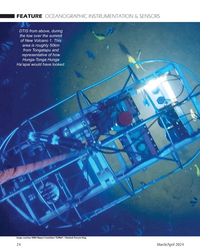 )
March 2024 - Marine Technology Reporter page: 24
)
March 2024 - Marine Technology Reporter page: 24FEATURE OCEANOGRAPHIC INSTRUMENTATION & SENSORS DTIS from above, during the tow over the summit of New Volcano 1. This area is roughly 50km from Tongatapu and representative of how Hunga-Tonga Hunga Ha’apai would have looked. Image courtesy NIWA-Nippon Foundation TESMaP / Rebekah Parsons-King 24
-
 )
March 2024 - Marine Technology Reporter page: 22
)
March 2024 - Marine Technology Reporter page: 22FEATURE OCEANOGRAPHIC INSTRUMENTATION & SENSORS Aerial view of HT-HH volcano, showing new multibeam depth data overlaid on islands satellite image. © SEA-KIT, NIWA-Nippon Foundation TESMaP 22 March/April 2024 MTR #3 (18-33).indd 22 4/4/2024 9:08:10 AM
-
 )
March 2024 - Marine Technology Reporter page: 20
)
March 2024 - Marine Technology Reporter page: 202024 Editorial Calendar January/Februay 2024 February 2024 March/April 2024 Ad close Jan.31 Ad close March 21 Ad close Feb. 4 Underwater Vehicle Annual Offshore Energy Digital Edition ?2?VKRUH:LQG$)ORDWLQJ)XWXUH ?2FHDQRJUDSKLF?QVWUXPHQWDWLRQ 6HQVRUV ?6XEVHD'HIHQVH ?6XEVHD'HIHQVH7KH+XQWIRU ?0DQLS
-
 )
March 2024 - Marine Technology Reporter page: 15
)
March 2024 - Marine Technology Reporter page: 15sensor options for longer mission periods. About the Author For glider users working in ? sheries and conservation, Shea Quinn is the Product Line Manager the Sentinel can run several high-energy passive and active of the Slocum Glider at Teledyne Webb acoustic sensors, on-board processing, and imaging
-
 )
March 2024 - Marine Technology Reporter page: 13
)
March 2024 - Marine Technology Reporter page: 13the capabilities and endurance of the vehicle. Teledyne Webb Research (TWR) was founded as Webb Research in 1982 by Doug Webb, an engineer at the Woods Hole Oceanographic Institution and pioneer of buoyancy engine driven underwater vehicles – unmanned plat- forms that use a pump to create chang- es
-
 )
March 2024 - Marine Technology Reporter page: 6
)
March 2024 - Marine Technology Reporter page: 6MTR Editorial Advisors Gallaudet Hardy The Honorable Tim Gallaudet, Kevin Hardy is President PhD, Rear Admiral, U.S. of Global Ocean Design, Navy (ret) is the CEO of creating components and Ocean STL Consulting and subsystems for unmanned host of The American Blue vehicles, following a career
-
 )
March 2024 - Marine Technology Reporter page: Cover
)
March 2024 - Marine Technology Reporter page: CoverMARINE TECHNOLOGY REPORTER March/April 2024March/April2024 www.marinetechnologynews.com Oceanographic Instrumentation Exploring Submarine Volcanoes When the Shooting Stops Black Sea Mine Clearance Subsea Mining The Nodule Collectors Lander Lab Volume 67 Number 3 Battery Packs MarineTechn
-
 )
April 2024 - Maritime Reporter and Engineering News page: 27
)
April 2024 - Maritime Reporter and Engineering News page: 27RADM PHILIP SOBECK, MILITARY SEALIFT COMMAND With COVID, we had to make some hard choices for our Do your CIVMARs have upward mobility? mariners because we couldn’t rotate. Many of our mariners The Navy has Sailors who become “Mustangs,” and work found other employment, and were able to use their skills
-
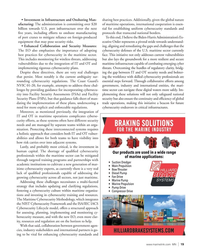 )
April 2024 - Marine News page: 19
)
April 2024 - Marine News page: 19• Investment in Infrastructure and Onshoring Man- sharing best practices. Additionally, given the global nature ufacturing: The administration is committing over $20 of maritime operations, international cooperation is essen- billion towards U.S. port infrastructure over the next tial for establishing
-
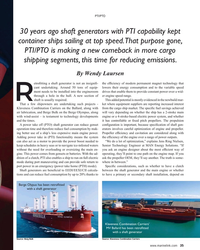 )
February 2024 - Maritime Reporter and Engineering News page: 35
)
February 2024 - Maritime Reporter and Engineering News page: 35PTI/PTO 30 years ago shaft generators with PTI capability kept container ships sailing at top speed. That purpose gone, PTI/PTO is making a new comeback in more cargo shipping segments, this time for reducing emissions. By Wendy Laursen etro? tting a shaft generator is not an insigni? - the ef? ciency
-
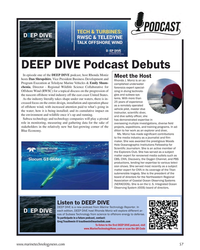 )
January 2024 - Marine Technology Reporter page: 57
)
January 2024 - Marine Technology Reporter page: 57, Blue Economy. Ms. Moniz has made signi? cant contributions to the media industry as a journalist and ? lm- maker. She was awarded the prestigious Woods Hole Oceanographic Institutions Fellowship for Scienti? c Journalism. She is an active member of the Explorers Club. She has served as a subject
-
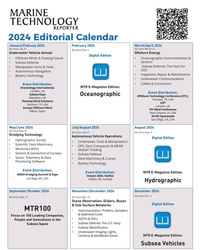 )
January 2024 - Marine Technology Reporter page: 53
)
January 2024 - Marine Technology Reporter page: 532024 Editorial Calendar January/Februay 2024 February 2024 March/April 2024 Ad close Jan.31 Ad close March 21 Ad close Feb. 4 Underwater Vehicle Annual Offshore Energy Digital Edition ?2?VKRUH:LQG$)ORDWLQJ)XWXUH ?2FHDQRJUDSKLF?QVWUXPHQWDWLRQ 6HQVRUV ?6XEVHD'HIHQVH ?6XEVHD'HIHQVH7KH+XQWIRU ?0DQLS
-
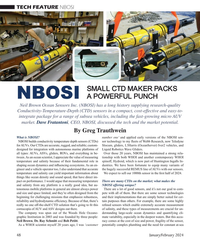 )
January 2024 - Marine Technology Reporter page: 48
)
January 2024 - Marine Technology Reporter page: 48measurement cornucopia of AUV and ASV designs out there. of salinity, and these types of measurements are crucial for un- The company was spun out of the Woods Hole Oceano- derstanding large-scale ocean dynamics and quantifying cli- graphic Institution in 2003 and was founded by three people: mate variability
-
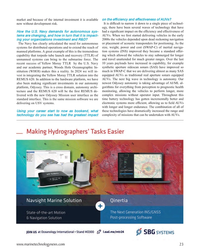 )
January 2024 - Marine Technology Reporter page: 23
)
January 2024 - Marine Technology Reporter page: 23the last recent success of Yellow Moray TTLR by the U.S. Navy 10 years payloads have increased in capability, for example and our academic partner, Woods Hole Oceanographic In- synthetic aperture sidescan sonars (SAS) have improved so stitution (WHOI) makes this a reality. In 2024 we will in- much in
-
 )
January 2024 - Marine Technology Reporter page: 16
)
January 2024 - Marine Technology Reporter page: 16INSIGHTS SCIENCE RESEARCH MANAGEMENT Map of NOC vessel operations from April 2022 – March 2023. Green = RRS James Cook, Blue = RRS Discovery Credit: NOC bon output, with an ambition of reaching net zero by 2040. MFP to be able to undertake the same project management and international collaboration.
-
 )
January 2024 - Marine Technology Reporter page: 14
)
January 2024 - Marine Technology Reporter page: 14INSIGHTS SCIENCE RESEARCH MANAGEMENT © Who is Danny/AdobeStock PAVING THE WAY IN INTERNATIONAL SCIENCE RESEARCH MANAGEMENT Dr. Eleanor Darlington, Head of Marine Facilities Programs at the National Oceanography Centre (NOC), discusses how NOC is paving the way in international science research
-
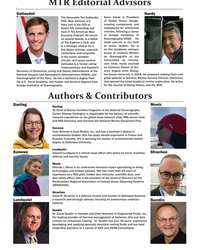 )
January 2024 - Marine Technology Reporter page: 6
)
January 2024 - Marine Technology Reporter page: 6MTR Editorial Advisors Gallaudet Hardy The Honorable Tim Gallaudet, Kevin Hardy is President PhD, Rear Admiral, U.S. of Global Ocean Design, Navy (ret) is the CEO of creating components and Ocean STL Consulting and subsystems for unmanned host of The American Blue vehicles, following a career
-
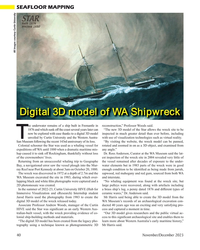 )
November 2023 - Marine Technology Reporter page: 40
)
November 2023 - Marine Technology Reporter page: 40images courtesy Curtin University Digital 3D model of WA Shipwreck he underwater remains of a ship built in Fremantle in reconstruction,” Professor Woods said. 1876 and which sunk off the coast several years later can “The new 3D model of the Star allows the wreck site to be now be explored with ease
